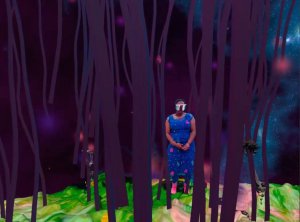Sensoryethnography: Difference between revisions
(updated the image! hi!!!!) |
|||
| (One intermediate revision by the same user not shown) | |||
| Line 1: | Line 1: | ||
[[File:Digital-art-pic.png|center|frameless]] | [[File:Digital-art-pic.png|center|frameless]] | ||
== Forest Walking == | === Forest Walking === | ||
https://titipi.org/wiki/images/8/89/Digital-art-pic.png | |||
Tactile Analytics | |||
Touching as a Collective Act | |||
Playing with the small, knitted swatch of alpaca wool in my hand, I lost | |||
track of time. The small piece of textile had become a riddle for me. The | |||
swatch was made up of rice stitches overlaid with a large diamond shape | |||
that formed a braided design. I kept feeling the weave, the tautness of each | |||
knot, rubbing my fingers | |||
back and forth. But at first my touch was blind | |||
to the culture and craft of the artisan’s work. It would take me months to | |||
learn to feel the material qualities of alpaca wool, to appreciate the knowledge | |||
conveyed through touch. The knitted surface was as important | |||
as | |||
the design; it interlaced sociocultural negotiations, histories, and layers of | |||
meaning (Alvarez Astacio 2015). To appreciate the density of this surface, | |||
I had to learn a different | |||
form of touch that could recognize the ontological | |||
complexity of this material surface. At the very least, I need to recognize | |||
the gap between my own conditioned tactility and that which is materialized | |||
in alpaca textiles. | |||
Within the fashion industry, alpaca wool is considered a luxury material; | |||
it is softer, lighter, and stronger than cashmere or sheep wool. Alpaca | |||
wool garments and accessories are especially valued for their ability to | |||
trigger imaginaries of pristine Andean indigenous communities. They | |||
are marketed as eco-friendly, | |||
long-lasting, | |||
and resistant to stains, odors, | |||
flames, and wrinkles. Alpaca wool is indeed a high-quality | |||
material, valued | |||
by twenty-first- | |||
century | |||
consumers and contemporary | |||
indigenous artisans | |||
in the highlands, but for different | |||
reasons. | |||
Latest revision as of 12:42, 10 May 2023

Forest Walking
https://titipi.org/wiki/images/8/89/Digital-art-pic.png
Tactile Analytics
Touching as a Collective Act
Playing with the small, knitted swatch of alpaca wool in my hand, I lost
track of time. The small piece of textile had become a riddle for me. The
swatch was made up of rice stitches overlaid with a large diamond shape
that formed a braided design. I kept feeling the weave, the tautness of each
knot, rubbing my fingers
back and forth. But at first my touch was blind
to the culture and craft of the artisan’s work. It would take me months to
learn to feel the material qualities of alpaca wool, to appreciate the knowledge
conveyed through touch. The knitted surface was as important
as
the design; it interlaced sociocultural negotiations, histories, and layers of
meaning (Alvarez Astacio 2015). To appreciate the density of this surface,
I had to learn a different
form of touch that could recognize the ontological
complexity of this material surface. At the very least, I need to recognize
the gap between my own conditioned tactility and that which is materialized
in alpaca textiles.
Within the fashion industry, alpaca wool is considered a luxury material;
it is softer, lighter, and stronger than cashmere or sheep wool. Alpaca
wool garments and accessories are especially valued for their ability to
trigger imaginaries of pristine Andean indigenous communities. They
are marketed as eco-friendly,
long-lasting,
and resistant to stains, odors,
flames, and wrinkles. Alpaca wool is indeed a high-quality
material, valued
by twenty-first-
century
consumers and contemporary
indigenous artisans
in the highlands, but for different
reasons.